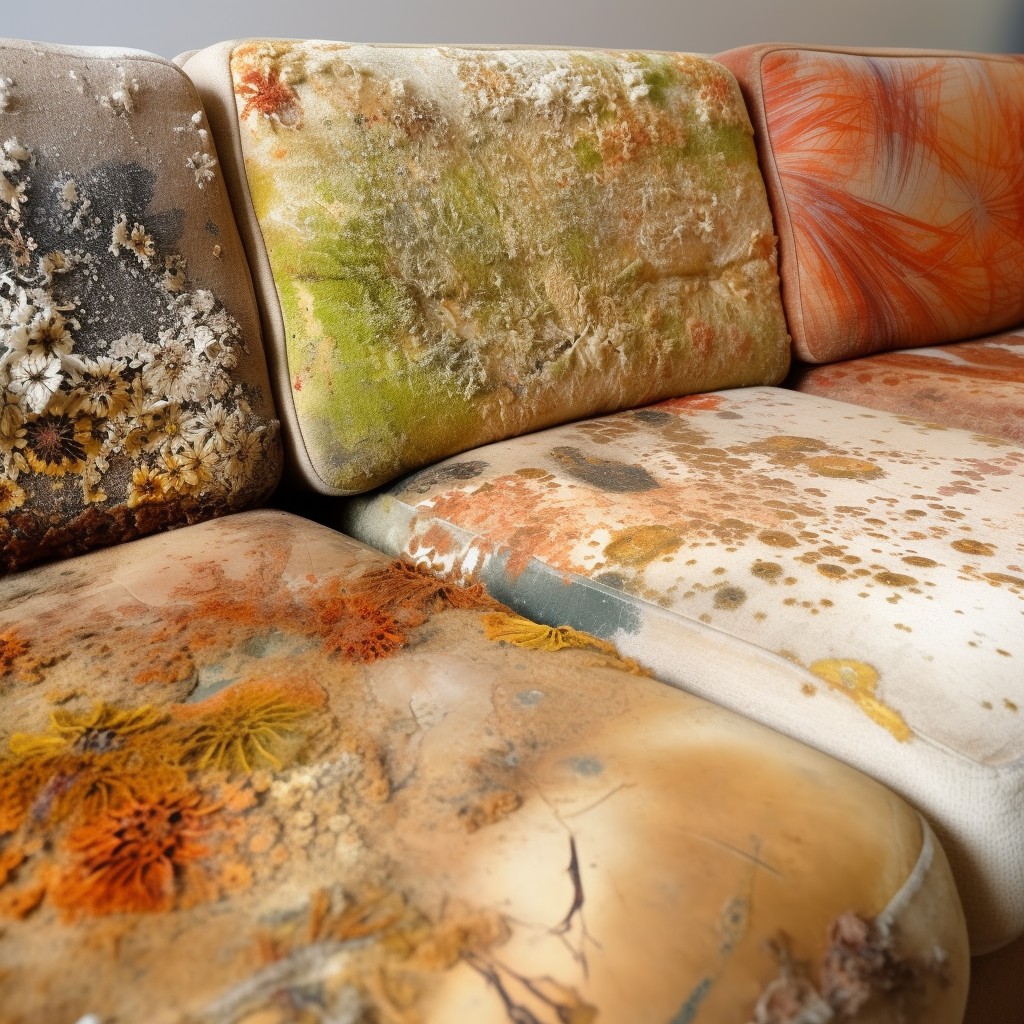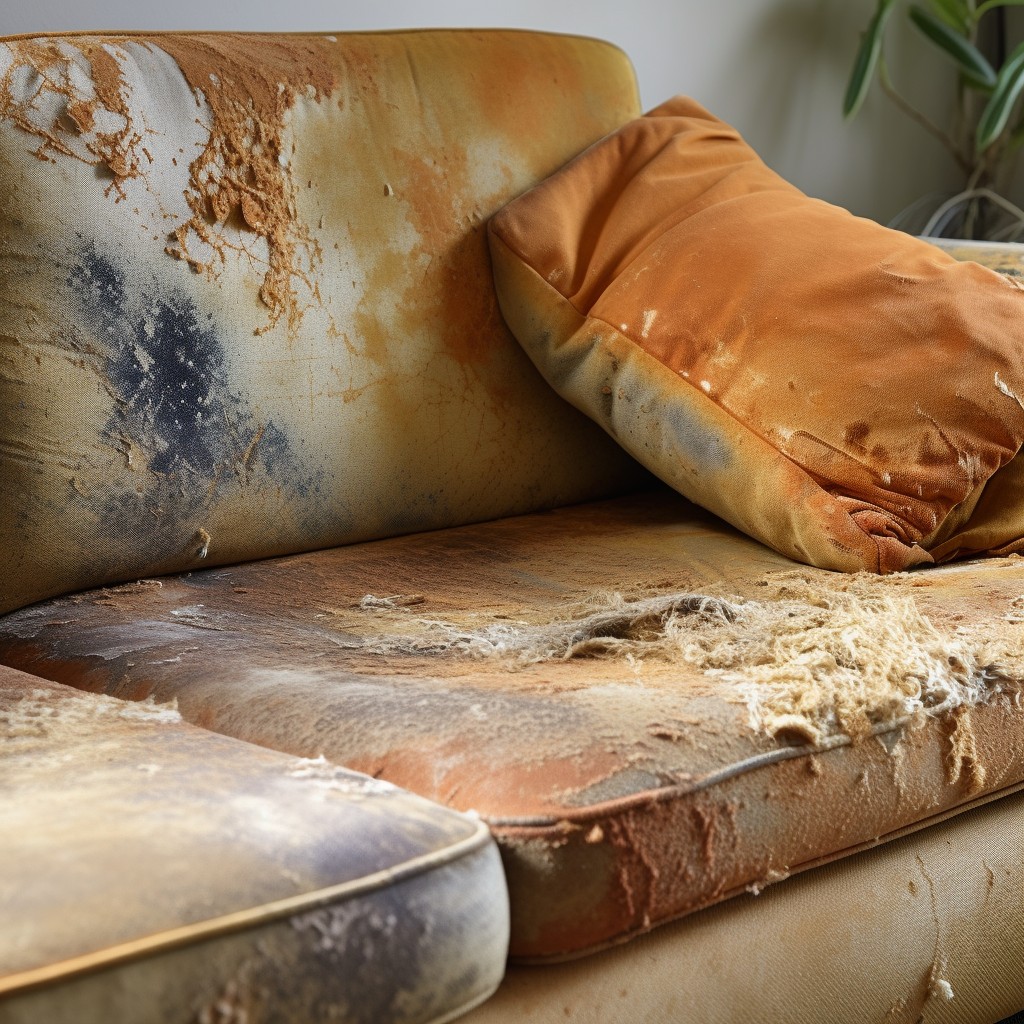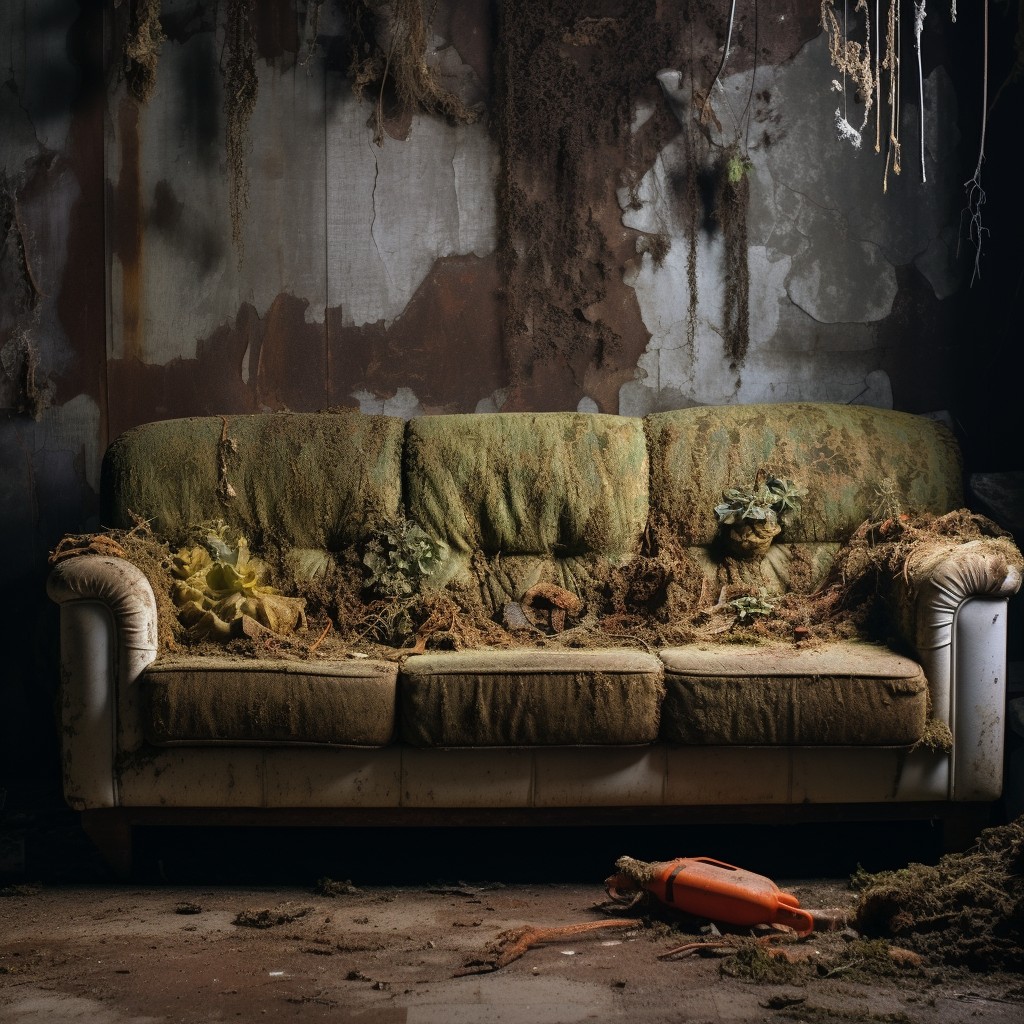Last updated on
Discover the telltale signs of mold on a couch and how to identify them in order to maintain a clean and healthy living space.
Mold is a common problem in many households, and it can grow on almost anything that provides the right conditions for its growth. Unfortunately, your couch is not an exception.
Couches are often made of materials that provide a suitable environment for mold growth. But how do you know if your couch has mold? What does mold on a couch look like? In this article, we will explore everything you need to know about identifying and dealing with mold on your couch.
So let’s dive in!
Table of Contents
Identifying Mold On Couches

Mold on a couch can be difficult to identify, especially if it’s in its early stages. However, there are some telltale signs that you should look out for.
One of the most obvious signs is discoloration or staining on your couch fabric. Mold often appears as black or green spots and can spread quickly if left untreated.
Another way to identify mold growth is by using your sense of smell. If you notice a musty odor coming from your couch, it could be an indication that mold has started growing inside the cushions or upholstery.
In addition to these visual and olfactory cues, pay attention to any physical symptoms you may experience while sitting on the affected furniture such as sneezing fits or skin irritation – this could also indicate mold presence.
Common Types of Mold On Furniture

The most common types of mold found on furniture include Aspergillus, Cladosporium, and Stachybotrys chartarum (also known as black mold).
Aspergillus is a type of fungus that grows in warm and humid conditions. It can cause respiratory problems such as asthma or allergies if inhaled.
This type of mold often appears greenish-yellow or brown.
Cladosporium is another common household fungus that thrives in damp environments like bathrooms and basements. It has a powdery appearance with dark spots.
Black Mold (Stachybotrys chartarum) is the most dangerous form of household fungi because it produces mycotoxins which are harmful to humans when ingested or breathed-in over time. Black molds appear slimy with a greenish-black coloration.
It’s important to note that not all molds have visible signs; sometimes they may be hidden within the fibers making them difficult to detect without professional help.
Signs of Mold Growth On Upholstery

Mold can appear in a variety of colors, including black, green, white or gray. If you notice any unusual spots or stains on your couch that weren’t there before and they are accompanied by a musty odor, it’s likely that mold has started to grow.
Another sign to look out for is an increase in allergies or respiratory problems among household members. Mold spores can cause allergic reactions such as sneezing and coughing when they are breathed in.
If you suspect that your couch may have mold growth but cannot see any visible signs yet, try using a flashlight to inspect the crevices between cushions and underneath them where moisture tends to accumulate.
It’s important not to ignore these warning signs as prolonged exposure could lead to serious health issues down the line.
Causes of Mold On Couches

One of the most common causes is high humidity levels in your home. When the air inside your house is too humid, it creates an ideal environment for mold growth on furniture and other surfaces.
Another cause of mold growth on couches is water damage. If you spill liquid or expose your couch to moisture, it can create a breeding ground for mold spores to grow and spread throughout the fabric.
Poor ventilation in your home can also contribute to mold growth on furniture like sofas and armchairs. Without proper airflow, moisture accumulates around these pieces of furniture which encourages fungal development.
Lastly, dirty upholstery that has not been cleaned regularly may harbor dust mites or other allergens that could lead to increased humidity levels within its fibers – this provides another opportunity for molds spores to thrive.
Health Risks Associated With Mold
Exposure to mold spores can cause allergic reactions, respiratory problems, and even infections in some cases. The symptoms of mold exposure may include coughing, sneezing, wheezing or shortness of breath; eye irritation; skin rash or irritation; headache; fatigue and fever.
If you have a weakened immune system due to an underlying medical condition such as asthma or allergies, the effects of mold exposure could be more severe. Children are also at risk because their developing immune systems are more vulnerable than adults’.
Therefore it’s essential that you take immediate action if you suspect there is any presence of mold on your couch.
Effects of Mold On Health and Furniture
Mold spores can cause respiratory problems, allergies, and other health issues if inhaled or ingested. Exposure to mold for prolonged periods of time may lead to chronic illnesses such as asthma or bronchitis.
In addition to the negative impact on human health, mold growth can also damage furniture irreparably. Couches that are infested with mold will begin to smell musty and unpleasant over time.
The fungus feeds off organic materials like wood frames, foam cushions, fabric upholstery causing them to deteriorate rapidly.
If left untreated for too long a period of time the structural integrity of the couch may be compromised leading it being unsafe for use altogether.
Preventing Mold Growth On Couches
The best way to prevent mold from growing on your couch is by controlling the humidity levels in your home. Mold thrives in damp and humid environments, so it’s important to keep indoor humidity levels below 60%.
You can use a dehumidifier or air conditioner to regulate the moisture level in your home.
Another effective way of preventing mold growth on couches is by ensuring proper ventilation. Open windows and doors regularly, especially during humid weather conditions, as this will help circulate fresh air throughout the room.
Regular cleaning of upholstery also helps prevent mold growth on furniture. Vacuuming removes dust particles that could provide food for molds while wiping down surfaces with an anti-fungal solution kills any spores that may have landed there.
Lastly, consider investing in materials that are resistant to moisture and mildew when purchasing new furniture pieces such as sofas or chairs for your living space. Leather or vinyl upholstered furniture tends not only looks great but also resists water damage better than other fabrics like cotton which absorbs water easily making them more susceptible to developing molds over time.
Indoor Humidity and Mold Growth
Mold thrives in damp environments, making it essential to keep indoor humidity levels low. High levels of moisture in your home can be caused by various factors such as poor ventilation, water leaks, or even cooking and showering.
To prevent mold growth on your couch due to high indoor humidity levels, you need to maintain a relative humidity level between 30% and 50%. You can use a hygrometer to measure the relative humidity level in your home accurately.
If you notice that the air inside your house is too humid for comfort or if there are signs of mold growing on any surface including upholstery fabrics like those found on sofas or chairs then it’s time for action! There are several ways you can reduce indoor moisture content:
- Use dehumidifiers: These devices help remove excess moisture from the air.
- Increase ventilation: Open windows when possible; install exhaust fans where necessary.
- Fix leaks promptly: Repair any plumbing issues immediately.
- By controlling indoor humidity through these measures above will not only prevent mold growth but also improve overall air quality within homes.
Regular Couch Maintenance to Prevent Mold
Regular cleaning and upkeep can help prevent the buildup of moisture, which is a common cause of mold growth. Here are some tips for maintaining your couch:
1. Vacuum regularly: Use a vacuum cleaner with an upholstery attachment to remove dust, dirt, and debris from your couch.
2. Keep it dry: Avoid spilling liquids or leaving wet items on the couch for extended periods of time.
3. Air it out: Open windows or use fans to increase air circulation in the room where your couch is located.
4. Check humidity levels: Use a hygrometer to monitor indoor humidity levels and keep them below 60%.
5. Rotate cushions regularly: This helps distribute wear evenly across all cushions while also allowing each cushion ample time to air out between uses.
Couch Material Considerations to Prevent Mold
Some materials are more prone to mold than others, and knowing which ones they are can help you make an informed decision when purchasing new furniture or maintaining existing pieces.
Natural fibers such as cotton and wool tend to absorb moisture easily, making them susceptible to mold growth. Leather is also at risk if not properly cared for since it can develop mildew in humid environments.
On the other hand, synthetic materials like polyester and nylon have less porosity than natural fibers; hence they do not absorb moisture as quickly.
If you live in a humid climate or have experienced water damage in your home before, consider investing in furniture made from synthetic materials that resist moisture absorption better than natural fabrics. Ensure proper ventilation by keeping windows open during dry weather conditions or using dehumidifiers indoors during wet seasons.
Cleaning Mold From Upholstery
The longer the mold stays on your upholstery, the harder it will be to remove and the more damage it can cause. Here are some steps you can take to clean mold from upholstery:
1. Wear protective gear: Before cleaning any type of mold, make sure that you wear gloves, a mask or respirator and eye protection.
2. Vacuum: Use a vacuum cleaner with an upholstery attachment to remove loose spores and debris.
3. Apply cleaning solution: Mix one part white vinegar with one part water in a spray bottle or use commercial cleaners designed for removing mildew/mold stains.
4. Test first: Always test any cleaning solution in an inconspicuous area before applying all over the affected area of your couch fabric/leather/upholstery material.
- Apply Solution & Scrub Gently: Spray enough solution onto affected areas then scrub gently using soft-bristled brush until visible signs of molds disappear completely.
- Rinse thoroughly: Rinse off excess cleaner by wiping down with damp cloth several times until no residue remains.
- Dry Completely: Allow furniture piece dry completely under direct sunlight if possible or use fans/hair dryer set at low heat setting.
Safe Mold Removal Methods
Removing mold can be dangerous if not done properly. Here are some safe methods for removing mold from your couch:
1. Use a HEPA vacuum: A high-efficiency particulate air (HEPA) vacuum can effectively remove surface-level spores and prevent them from spreading.
2. Apply vinegar or hydrogen peroxide: These natural cleaners are effective at killing most types of molds and preventing their growth.
3. Use baking soda: Baking soda is an excellent natural cleaner that absorbs moisture and neutralizes odors caused by the presence of molds.
4. Hire a professional: If the infestation is severe or covers a large area, consider hiring a professional to handle the removal process safely.
Ways to Remove Mold From Fabric Furniture
Mold can cause health problems and damage the furniture if left untreated. Here are some ways to remove mold from fabric furniture:
1. Use a vacuum cleaner: Start by using a vacuum cleaner with an upholstery attachment to clean the affected area thoroughly.
2. Apply vinegar solution: Mix equal parts of white vinegar and water in a spray bottle, then apply the solution directly onto the affected area.
3. Use baking soda: Sprinkle baking soda over the affected area and let it sit for 15-20 minutes before brushing or vacuuming off.
4. Try hydrogen peroxide: Mix one part hydrogen peroxide with two parts water in a spray bottle, then apply directly onto the moldy spot.
5. Use commercial cleaners – There are many commercial cleaners available that can effectively kill mold on fabric furniture; just make sure they are safe for use on your specific type of upholstery material.
It’s important not only to remove visible signs of mold but also address any underlying moisture issues that may be causing its growth in order prevent future occurrences.
How to Remove Mold From Couch Fabric
Mold can cause health problems and damage the fabric of your furniture if left untreated. Here are some steps you can follow to safely remove mold from couch fabric:
1. Wear protective gear: Before starting the cleaning process, make sure you wear gloves, a mask and eye protection.
2. Vacuum the affected area: Use a vacuum cleaner with a HEPA filter attachment to suck up any loose spores or debris.
3. Apply cleaning solution: Mix equal parts of white vinegar and water in a spray bottle or use an anti-fungal cleaner specifically designed for upholstery fabrics.
4. Test on small area first: Test the solution on an inconspicuous part of your couch before applying it all over as some solutions may discolor certain types of fabrics.
5. Apply Solution: Spray generously onto affected areas until they are saturated with solution.
6. Scrub gently: Using soft-bristled brush scrub gently in circular motion.
7. Rinse thoroughly: Dampen clean cloth with warm water, wring out excess moisture then wipe down treated areas.
8. Dry completely – Open windows or turn fans towards cleaned surfaces so that air circulates around them. If possible leave cushions outside under direct sunlight for few hours.
Mold Removal Safety Measures
Mold spores can cause serious health problems when inhaled or ingested, so it’s important to take precautions before attempting any mold removal process.
Firstly, ensure that you wear protective gear such as gloves and a mask while removing mold from your couch. This will prevent direct contact with the mold and reduce your risk of inhaling harmful spores.
Secondly, make sure that the room is well-ventilated during the cleaning process. Open windows and doors to allow fresh air into space while also using fans or dehumidifiers to keep humidity levels low.
Thirdly, avoid using bleach on porous materials like upholstery as it may damage them further instead of killing off all molds present on them. Instead use specialized products designed for removing molds from fabrics which are safe for both furniture material and human health.
Lastly but most importantly seek professional help if necessary especially when dealing with large areas affected by molds or persistent cases where home remedies have failed repeatedly despite following all safety measures mentioned above.
When to Replace a Moldy Couch
If you have tried cleaning and removing the mold but it keeps coming back, or if the damage is too extensive, then replacing your couch may be necessary. If anyone in your household has allergies or respiratory issues that are being exacerbated by the presence of mold on your furniture, then a replacement may be needed for health reasons.
It’s important to note that simply covering up a moldy couch with new upholstery will not solve the problem. The underlying issue of moisture and humidity needs to be addressed before bringing in new furniture.
Replacing a piece of furniture can seem daunting and expensive at first glance; however investing in quality materials such as leather or synthetic fibers can help prevent future growths from occurring while also providing durability against wear-and-tear over time.
When to Call a Mold Professional
While some cases of mold can be removed with DIY methods, others require the expertise of a professional. Here are some signs that indicate it’s time to call in a mold removal specialist:
- The affected area is larger than 10 square feet.
- You have health issues such as allergies or asthma that could be aggravated by exposure to mold.
- The source of moisture causing the growth cannot be identified and fixed.
- You’ve attempted DIY removal but the problem persists.
Mold professionals have specialized equipment and training for identifying and removing all types of molds safely. They will also help identify any underlying causes for the growth so you can prevent future occurrences.
Remember, ignoring a potential mold issue can lead to serious health problems down the line.
What to Expect During Mold Removal
Mold removal can be a daunting task, but with the right approach and tools, you can get rid of the problem effectively. Here’s what to expect during mold removal:
1. Assessment: A professional will assess the extent of mold growth and determine if there are any underlying issues that need addressing.
2. Containment: The affected area will be contained using plastic sheeting or other materials to prevent spores from spreading.
3. Removal: The contaminated material will be removed carefully without disturbing spores in order not spread them further.
4. Cleaning: All surfaces in contact with molds should undergo thorough cleaning using appropriate disinfectants.
5. Drying: After cleaning ,the area must dry completely before replacing furniture or carpets.
6. Verification: Once everything has been cleaned up properly ,a final inspection is done by professionals for verification purposes.
It’s important to note that DIY methods may not always work when dealing with extensive mold growth on furniture like couches.
Dealing With Persistent Mold Issues
In such cases, it is best to seek the help of a professional mold removal service. These experts have the necessary equipment and expertise to identify and eliminate all traces of mold on your couch.
Before calling in a professional, ensure that you have taken all necessary precautions by removing any items near the affected area and turning off any HVAC systems or fans that could spread spores throughout your home during cleaning.
During their visit, they will conduct an inspection of your entire home for signs of moisture problems or other areas where mold may be growing. They will then use specialized tools like air scrubbers and HEPA vacuums to remove visible growths as well as airborne spores.
Afterward, they may recommend additional measures like dehumidifiers or ventilation improvements in order to prevent future growths from occurring again on furniture surfaces including sofas/couches etc., which are particularly susceptible due their porous nature.
Tips for Choosing Mold-Resistant Furniture
Some materials are more prone to mold than others, so it’s important to choose furniture that is resistant to mold. Here are some tips for selecting mold-resistant furniture:
- Choose leather or vinyl upholstery instead of fabric.
- Opt for solid wood or metal frames instead of particleboard or MDF.
- Look for antimicrobial treatments in cushions and padding.
- Avoid overly plush cushions that can trap moisture and promote mildew growth.
By following these tips when shopping for new furniture, you can reduce the risk of developing a serious problem with household molds down the line while also ensuring your home remains stylish and comfortable!
FAQ
How do I know if my couch has mold?
To determine if your couch has mold, examine for dirty-looking surfaces and test with a swab dipped in diluted bleach (1 part bleach, 16 parts water); if the spot lightens quickly or reappears after cleaning, it is likely mold.
Can a moldy couch be saved?
Yes, a moldy couch can be saved in minor cases by vacuuming and cleaning the upholstery using natural remedies such as rubbing alcohol on visible mold stains.
What kills mold on couch?
To kill mold on a couch, use a vinegar solution with equal parts vinegar and water, or for white fabrics and non-porous furniture, create a 1:10:20 ratio solution of detergent, bleach, and warm water.
Is mold on a couch bad?
Yes, mold on a couch is bad as it causes furniture to deteriorate, stain, and rot the fabric.
What are the common causes of mold growth on couches?
Common causes of mold growth on couches include excess moisture, high humidity, poor ventilation, and organic materials that serve as a food source.
How can I prevent mold from developing on my furniture?
To prevent mold from developing on your furniture, maintain low humidity, ensure good air circulation, and frequently clean and dry surfaces.
What health risks are associated with having mold on a couch?
Health risks associated with mold on a couch include respiratory issues, allergies, skin irritations, and potential exacerbation of asthma symptoms.





